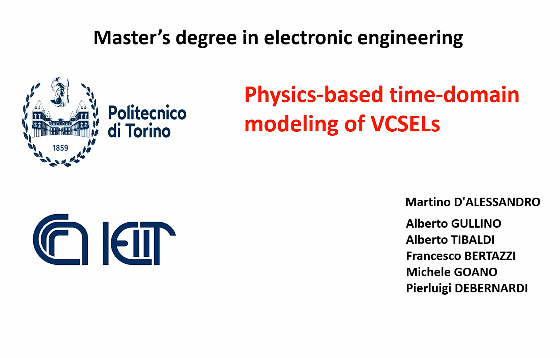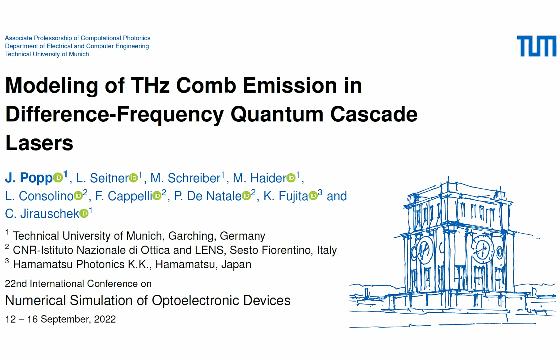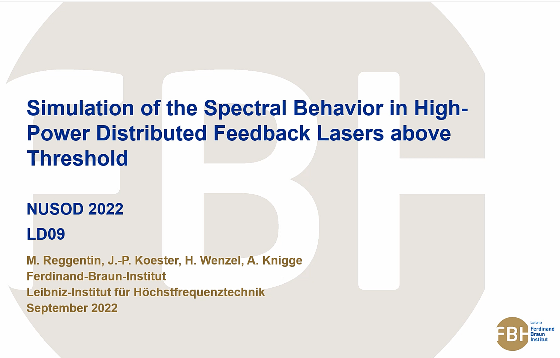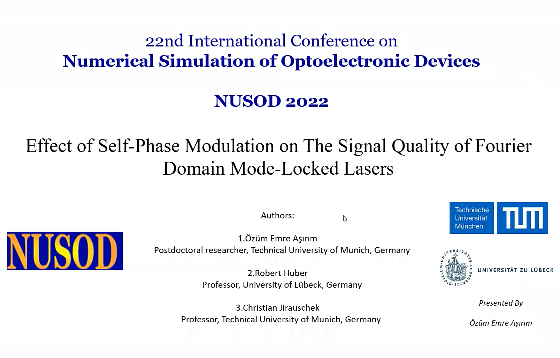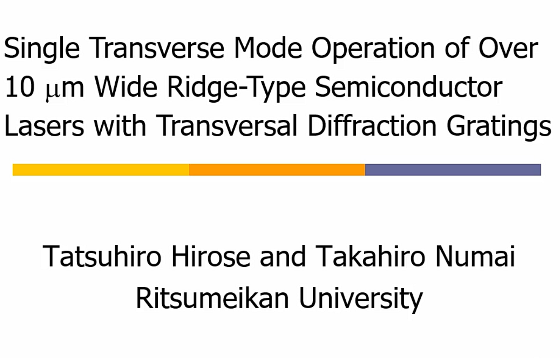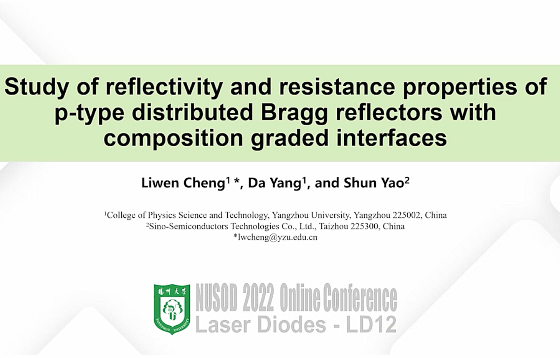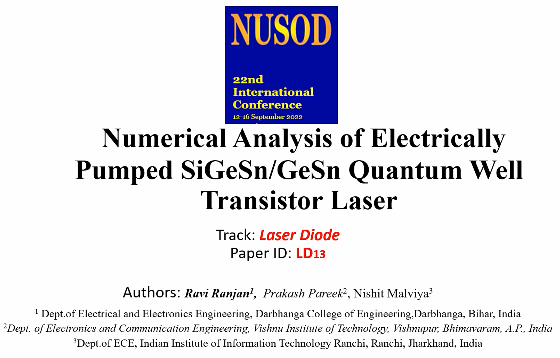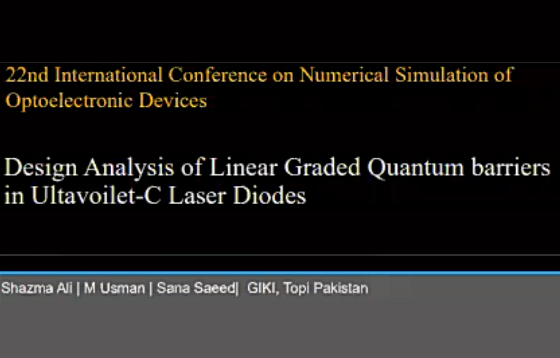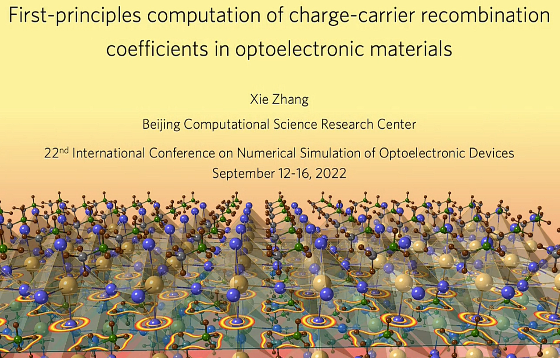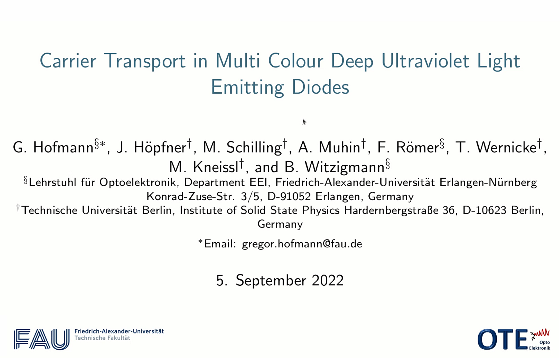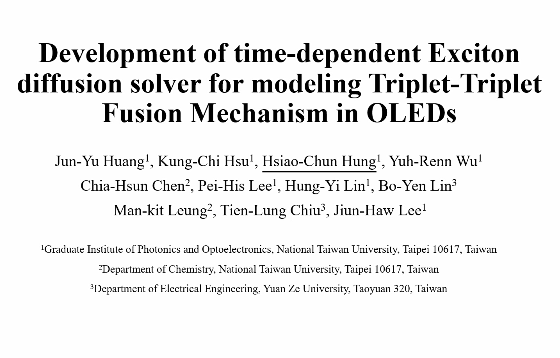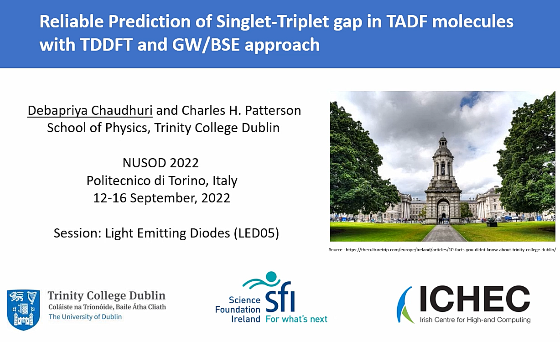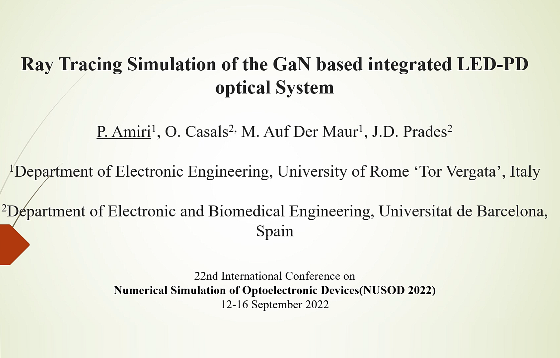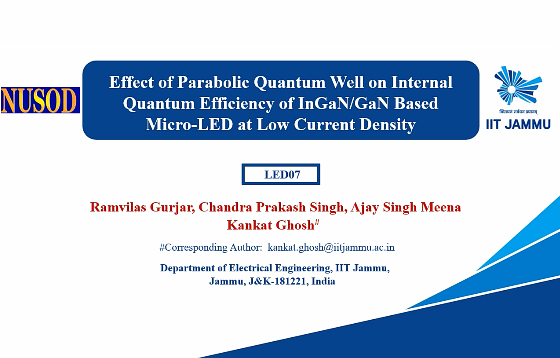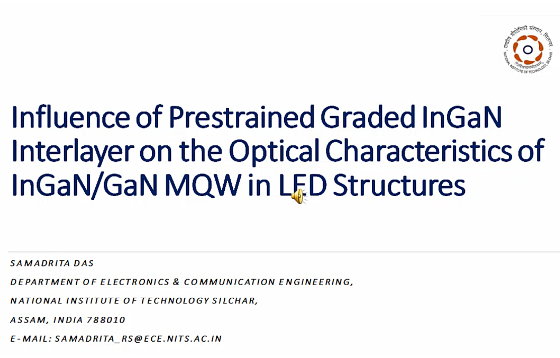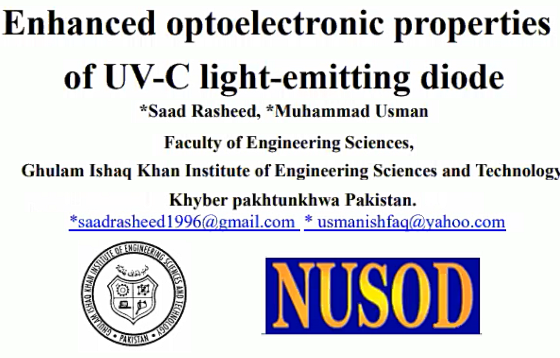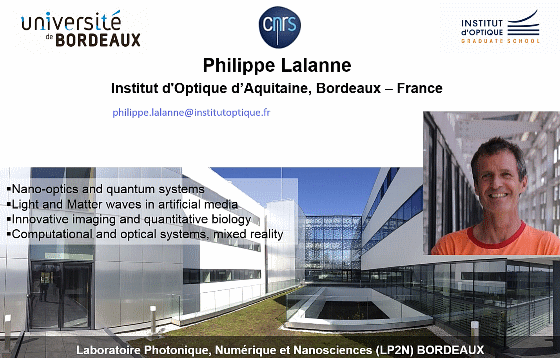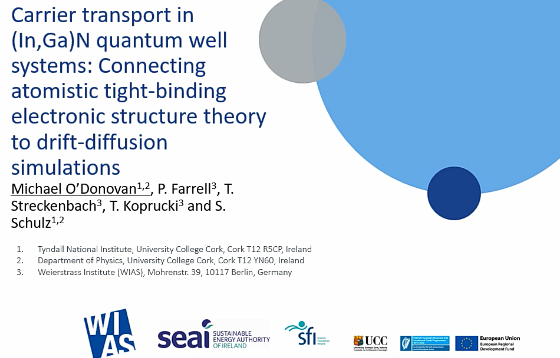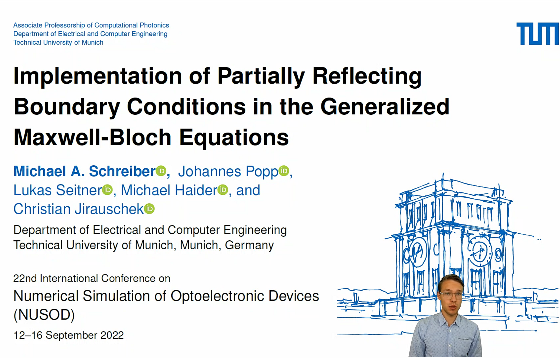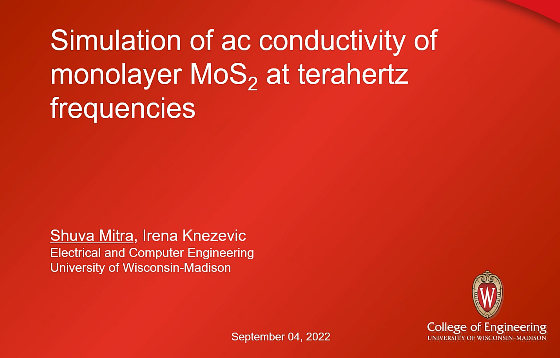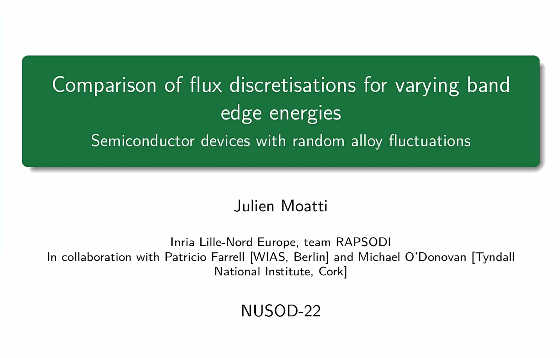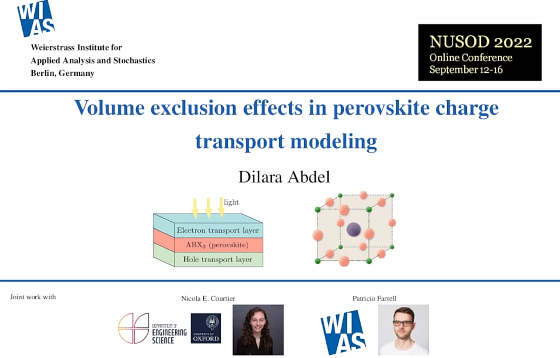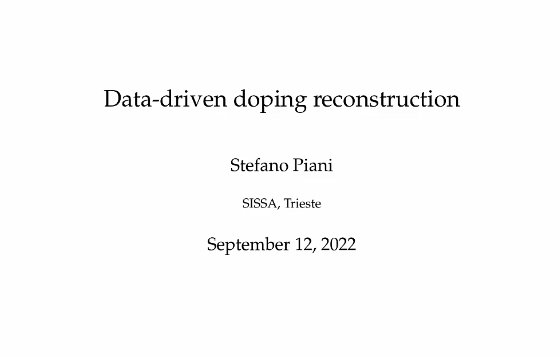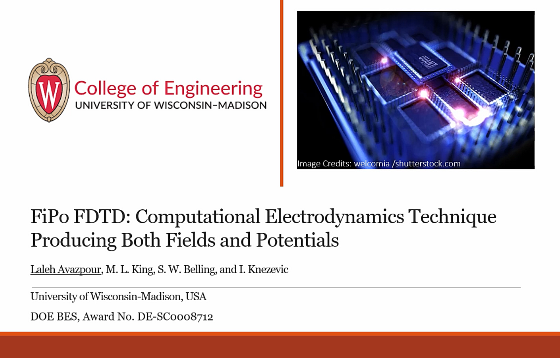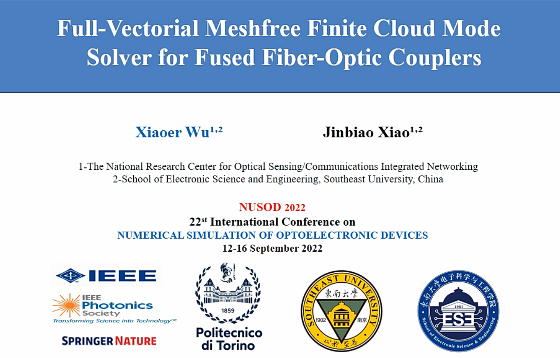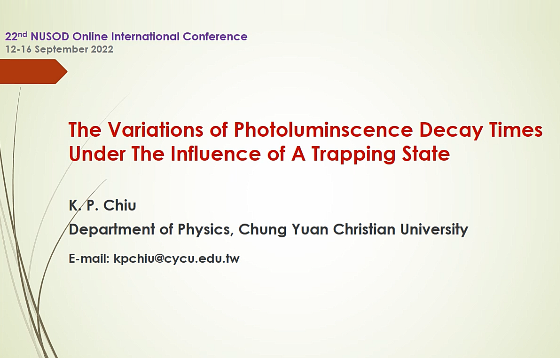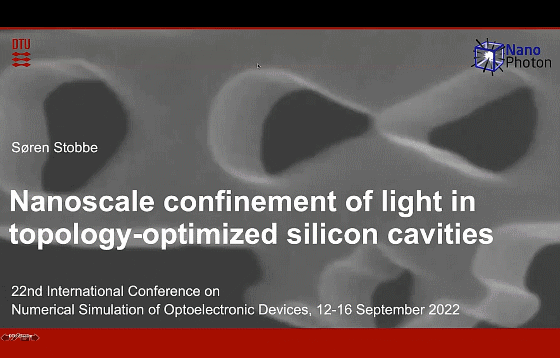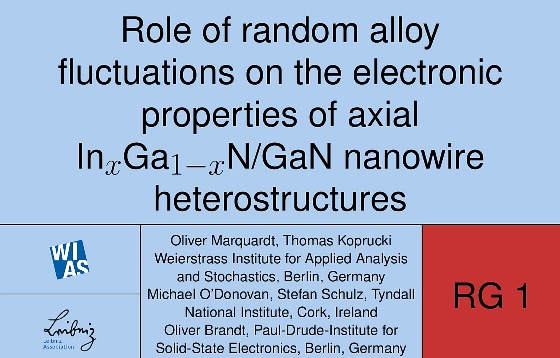


This paper presents the results of a physics-based time-domain simulator for a vertical-cavity surface-emitting laser (VCSEL). We implemented a trapezoidal rule second order backward differentiation formula (TR-BDF2) to simulate the large signal response of the device under investigation, including the parasitic effects of the pin junction arising from an interplay of optical and carrier transport […]
LD08 – Modeling of THz Comb Emission in Difference-Frequency Quantum Cascade Lasers
The generation of terahertz (THz) frequency comb emission by intracavity difference frequency generation (DFG) in a mid-infrared (mid-IR) quantum cascade laser (QCL) is a promising alternative to direct THz QCL frequency comb generation. Concerning their room temperature operation capabilities, these devices are well suited for applications in rotational molecular spectroscopy and sensing. In order to […]
LD09 – Simulation of the Spectral Behavior in High-Power Distributed Feedback Lasers above Threshold
We report on the simulations of mode hopping behavior in semiconductor distributed feedback lasers with asymmetric facet reflectivities above threshold and its dependence on the phase between the grating and the high reflective facet.
LD10 – Effect of Self-Phase Modulation on The Signal Quality of Fourier Domain Mode-Locked Lasers
In this paper, the impact of self-phase modulation on the noise performance of Fourier Domain Mode-Locked (FDML) lasers is investigated. It is shown that under a relatively high fiber nonlinearity and/or intracavity signal amplitude, an excess amount of noise generation occurs, which can not only lead to poor signal quality, but also operational instability. Hence, […]
LD11 – Single Transverse Mode Operation of Over 10 µm Wide Ridge-Type Semiconductor Lasers with Transversal Diffraction Gratings Tatsuhiro Hirose and Takahiro Numai
This paper reports on single transverse mode operation of a ridge-type semiconductor laser with transversal diffraction gratings for a mesa width over 10 µm when the number of periods is 160, the grating pitch is 428.7 nm, and the grating depth is 250 nm.
LD12 – Study of reflectivity and resistance properties of p-type distributed Bragg reflectors with composition graded interfaces
In this work, the reflectivity and series resistance of the p-type distributed Bragg reflectors (DBRs) in vertical cavity surface emitting lasers (VCSELs) under the different thickness of composition graded interface layers, Al composition of the high Al composition layers, Al composition of the low Al composition layers, and the number of DBR periods are simulated […]
LD13 – Numerical Analysis of Electrically Pumped SiGeSn/GeSn Quantum Well Transistor Laser
The threshold current density of electrically pumped Sn incorporated group IV alloy based transistor laser (TL) is analyzed by proposing and designing a theoretical model for the same. Active region for the lasing action is formed by strain compensated GeSn single quantum well (QW) in the base of the transistor. The threshold current density for […]
LD15 – Design Analysis of Linear Graded Quantum barriers in Ultravoilet-C Laser Diodes
We demonstrated ultraviolet laser diode with improved optical and electrical features. By employing linear graded rising aluminium concentration in phases from first quantum barrier to last quantum barrier, the suggested LD design improves internal quantum efficiency (IQE) and output power while minimizing the lasing threshold. The proposed LD increases optical gain while lowering carrier leakage […]
LED01 – First-principles computation of charge-carrier recombination coefficients in optoelectronic materials
Charge-carrier recombination plays a decisive role in determining the efficiency of optoelectronic materials and devices, but their accurate experimental measurements and interpretation are challenging. In this context, first-principles computation of charge-carrier recombination coefficients is particularly useful. It allows not only rigorous computation of the recombination rates, but also intuitive interpretation of the microscopic recombination mechanisms […]
LED02 – Carrier Transport in Multi Colour Deep Ultraviolet Light Emitting Diodes
Deep ultraviolet (DUV) light emitting diodes (LEDs) and lasers are enabled by high band gap Aluminium Gallium Nitride (AlGaN). The efficiency of recent multi quantum well (MQW) DUV emitters is still in the percent range which can be in part attributed to the hole injection. The hole injection and the carrier distribution in the high […]
LED03 – RGB LED active region design and optimization with Genetic Evolution Algorithm
Multi-quantum-well (MQW) LED is a complex distributed system with strong interaction between two opposite carrier flows, electrons and holes. For both types of carriers, the carrier injection into each QW depends on transport conditions across the whole active region (AR) and is affected by capture-recombination balance in all active QWs. Multi-color LEDs with different types […]
LED04 – Development of time-dependent Exciton diffusion solver for modeling Triplet-Triplet Fusion Mechanism in OLEDs
In this work, we developed a both stable and time-dependent exciton diffusion model including singlet and triplet exciton coupled with a modified Poisson & drift-diffusion solver to demonstrate the mechanism of triplet-triplet fusion (TTF) OLEDs. Using this modified simulator, we can demonstrate the characteristics of OLEDs including current-voltage curve, quantum efficiency performance, time-resolved electroluminescence spectrum, […]
LED05 – Reliable prediction of the singlet-triplet gap in TADF molecules with GW/BSE approach
Organic light emitting diode (OLED) molecules that exhibit thermally activated delayed fluorescence (TADF) have emerged as a promising technology for various lighting and display applications. Such systems depend on low singlet-triplet gaps of the order of kT to allow reverse inter-system crossing. Here, we demonstrate the capability of a GW/BSE method to predict excitation energies […]
LED06 – Ray Tracing Simulation of a GaN-based integrated LED-Photodetector System
An optical sensor system consisting of a pair of GaN LED and Photodetector (PD) is simulated using COMSOL Multiphysics, and the possibility of using this system as absorption coefficient sensor is studied. By locating both LED and PD on a same substrate and measuring transmitted power to the PD, it would be possible to sense […]
LED07 – Effect of Parabolic Quantum Well on Internal Quantum Efficiency of InGaN/GaN based MicroLED at low current density
The quantum cascade stark effect (QCSE) in rectangular shaped quantum well (QW) poses a hindrance to increase the internal quantum efficiency (IQE) of nitride based LEDs. To circumvent the said problem for micro-LEDs operating at low current density, a parabolic QW structure has been proposed which is found to be useful to alleviate the QCSE […]
LED08 – Influence of Prestrained Graded InGaN interlayer on the Optical Characteristics of InGaN/GaN MQW-based LEDs
In this work, an InGaN/GaN multi-quantum well light emitting diode is designed with different kinds of prestrain layers (InGaN) inserted between the active region and n-GaN layer to demonstrate the effects of piezoelectric polarization on GaN-based LEDs. The device describes a GaN buffer layer which promotes charge injection by minimizing energy barrier between electrode and […]
LED09 – Enhanced optoelectronic properties of UV-C light-emitting diode
We numerically analyzed proposed structure named as LED S2 in comparison to reference structure LED S1. In LED S2 we introduced undoped AlGaN and p-AlGaN layers between the electron blocking layer (EBL) and the p-GaN (hole injecting layer). The simulation finding shows proposed structure (LED S2) provide a better strategy for lowering electron overflow and […]
MM01 – Rigorous modal analysis of micro or nanoresonators
The most general motion of a system is a superposition of its normal modes, or eigenstates. We report our recent developments of a rigorous modal analysis of electromagnetic resonators, which is accurate even for geometries that have not been analyzed so far, e.g. 3D resonators made of dispersive media and placed in non-homogeneous backgrounds (on […]
MM02 – Carrier transport in (In,Ga)N quantum well systems: Connecting atomistic tight-binding electronic structure theory to drift-diffusion simulations
Understanding the impact of the alloy microstructure on carrier transport in (In,Ga)N/GaN quantum well systems is important for aiding device design. We study the impact that alloy fluctuations have on uni-polar carrier transport for both electrons (n-i-n junction) and holes (p-i-p junction) using a multiscale framework. To do so we connect an atomistic tight-binding model […]
MM03 – Implementation of Partially Reflecting Boundary Conditions in the Generalized Maxwell-Bloch Equations
Perfectly matched layer (PML) boundary conditions have been used for several decades for the simulation of open domains within the finite difference time domain (FDTD) method. In this paper, we report on a new PML-based partially reflecting boundary condition for the generalized Maxwell-Bloch equations that enables setting a certain value of reflectance R at the […]
MM04 – Simulation of ac conductivity of monolayer MoS2 at terahertz frequencies
We present a multiphysics numerical tool for calculating the terahertz (THz) conductivity of transition-metal dichalcogenides (TMDs). The tool combines the ensemble Monte Carlo (EMC) technique for carrier transport with a three-dimensional finite-difference-time-domain (FDTD) solver for electromagnetic fields. We use the coupled EMC–FDTD technique to calculate the frequency-dependent conductivity in the terahertz range for monolayer MoS2, […]
MM05 – Comparison of flux discretizations for varying band edge energies
Recently, a multiscale framework was developed where drift-diffusion is combined with atomistic tight-binding models. A naive flux discretization was proposed to tackle the problem of heavily fluctuating band edge energies which does not take into account mathematical complications. Here we would like to present several alternatives and compare them.
MM06 – Dual-Potential Finite-Difference Technique for Computational Electrodynamics
We present a finite-difference time-domain (FDTD) technique suitable for coupling with quantum-transport solvers. We derive first-order equations for the electric and magnetic vector potentials and the electric scalar potential which, upon the adoption of the Coulomb gauge, decouple into solenoidal and irrotational equation sets and are sourced by the solenoidal and irrotational parts of the […]
MM07 – Volume exclusion effects in perovskite charge transport modeling
Due to its flexibility, perovskite materials are a promising candidate for many semiconductor devices. For example, Perovskite Solar Cells (PSCs) have become recently one of the fastest growing photovoltaic technologies. In this work, we take volume exclusion effects into account by formulating two different current densities – either treating the mobility or the diffusion as […]
MM08 – Data-driven doping reconstruction
To reconstruct doping profiles via opto-electronic techniques (e.g. LBIC and LPS), we formulate an inverse problem based on the van Roosbroeck system. To solve it, we use neural networks fed with data created from efficient implementations of the forward model. We discuss errors of the reconstructed doping profiles as well as their robustness with respect […]
MM09 – FiPo FDTD: Computational Electrodynamics Technique Producing Both Fields and Potentials
We present the field–potential finite-difference time-domain (FiPo FDTD) algorithm, which solves a set of first-order equations for the electric and magnetic fields (E and H), as well as the magnetic vector potential A and the scalar electric potential φ in the Lorenz gauge. We also present the derivation and implementation of a convolutional perfectly matched […]
MM10 – Full-Vectorial Meshfree Finite Cloud Mode Solver for Fused Fiber-Optic Couplers
A novel full-vectorial meshfree finite cloud mode solver is proposed for analysis of fused optic-fiber couplers, in which the curvilinear coordinate mapping technique is used to map a cloud with curved interface onto a unit square. Numerical results are compared with prior analysis using the finite difference method, showing the validity and utility of the […]
MM11 – The Variations of Photoluminscence Decay Times Under The Influence of A Trapping State
We numerically calculated the time-resolved photoluminescence spectra using the bimolecular trapping-detrapping model. The variations of carrier lifetimes are investigated by changing the carrier recombination and trapping rate constants, as well as the concentration of available trapping states.
N02 – Influence of random alloy fluctuations on the electronic properties of axial In(x)Ga(1−x)N/GaN nanowire heterostructures
Compound semiconductor heterostructures such as quantum dots, nanowires, or thin films, are commonly subject to randomly fluctuating alloy compositions if they contain ternary and quaternary alloys. These effects are obviously of an atomistic nature and thus rarely considered in heterostructure designs that require simulations on a continuum level for theory-guided design or interpretation of observations. […]

